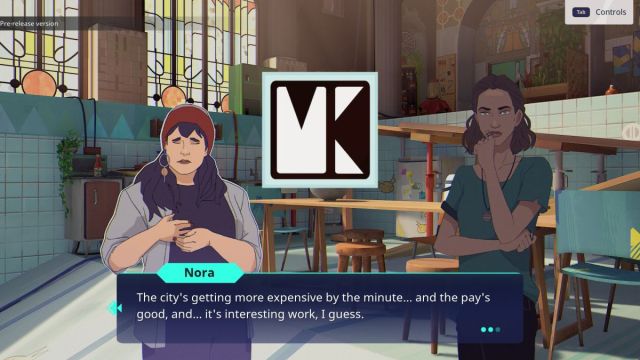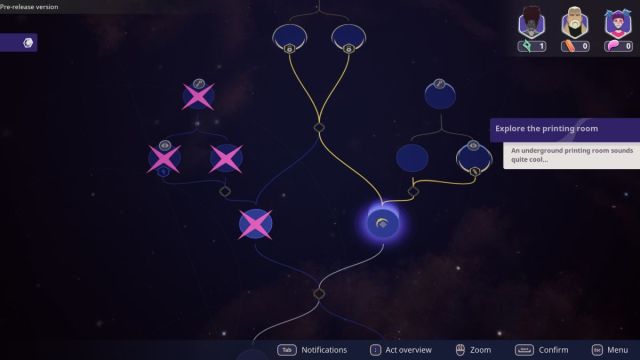The truth will be revealed in time
Harmony: The Fall of Reverie is a bit different from Don’t Nod’s previous work. It’s not the setting, as the studio is well-known for supernatural mysteries, whether it’s Life is Strange, Tell Me Why, or others. It’s the look of Harmony, and the form the story takes, that make this a peculiar and intriguing new story for Don’t Nod.
Right away, the difference is felt in Harmony‘s opening. It’s gorgeously animated, as protagonist Polly sets out for the day, surround by near-future tech. There’s a cutting-edge world pinned up against homes made in emptied pools that really sets a tone early on. Polly’s returned home to help search for her missing mother, Ursula, but soon gets swept up in much more than she bargained for in the Reverie.
This alternate world, Reverie, houses the various Aspirations of Humanity: Bliss and Power, Bond and Glory, Truth and Chaos. Here, Polly becomes Harmony, a force that can utilize clairvoyant powers and align with these Aspirations to determine a future, for both Reverie and the world.
All in due time
Maybe it was the gorgeous art, or maybe it was the deity-driven story, but both reminded me of The Wicked + The Divine. There’s an intriguing element of balance between the two stories, as Polly has to discover why she can access Reverie and what powers it’s given her, alongside the links it has to her mother’s disappearance.

In practice, this plays out in similar fashion to a visual novel. Aside from the aforementioned gorgeous cutscenes, most of the story is told in dialogue boxes between characters, as Polly searches in the world for clues while dealing with seemingly primal beings in the other world.
A big component of this is the timeline. Don’t Nod lays out the path ahead visually, so the branching paths are all visible. Each one has different options, with some choices opening up other branches and others locking off entire lines of inquiry if taken. It’s a neat structure that’s become more and more common in branching story-driven adventures, and Harmony: The Fall of Reverie does some interesting things with it, especially in linking the branching paths with its characters.
A blissful existence
Each deity embodies an emotion or aspiration, and so choices in the narrative can elicit crystals representing each aspect. Over time, you can start to define how you’d like to progress through the story; do you seek Power, or do you find strength in the Bonds you share with others? Those elements were compelling, and I thought it was a neat way to physically symbolize how Polly approached conflicts.
Where it hit some friction, for me, was in how those crystals are put into practice. Different icons on the flowchart might be inaccessible if you don’t have the right crystals, and the Outcomes—a greater resolution to the arc you’re on—are determined based on what crystals you have earned over the course of play.

This is where some of the long-spanning, timeline-analyzing aspects of Harmony got away from me. This is not a timeline-hopping game, it is a timeline-informing game. While you can move between options to some extent, you will eventually have to choose a side and lock it in. You’re working with more information than you’d normally have in, say, Life is Strange; I can see that, if I continue down my path, Polly will eventually be able to ally herself with the person I’m talking to. But I’m not jumping between viewpoints or alternate universes, as I would in other timeline-driven games.
So picking locks and determining a future course of action is still, ultimately, driven by choice. And the choice seems to rapidly shift between which deity you’d like to garner more favor from, and also which outcome you’d like to see as Polly and pals solve the real-world mystery. It’s that aspect that I find really intriguing, as my drive to spend time with certain deities might force me to act differently in the real world and vice versa, but some of the long-stretch planning and numbers game I was playing with crystals didn’t feel as compelling as that in-the-moment friction.
Pantheon of the gods
Still, I found the pantheon of Harmony: The Fall of Reverie interesting. I didn’t get much of a sense of the main real-world cast, though the scoop-chasing journalist Jade was a memorable encounter. But the Aspirations themselves add a good amount of life to what’s happening, and can even start to pop up in real-world events (unbeknownst to anyone but Polly) as commentators on what’s going on.

All this mystery and intrigue happens under the watchful eye of MK, a super-corporation that’s taken over the community. It’s a really interesting world that Don’t Nod has constructed, with music from Lena Raine backing all of it. It’s admittedly a slow burn, partly because of fiddling with the timeline. And especially at the beginning, some of the exposition can carry for a while.
Still, this is Don’t Nod doing something quite different with a supernatural mystery drama, and I’m intrigued by it. Even on production value alone, I think Harmony: The Fall of Reverie is worth keeping an eye on. There will be a demo available as part of this year’s LudoNarraCon. Otherwise, Harmony will launch on June 8 for PC and Switch, and on June 22 for PS5 and Xbox Series X|S.








